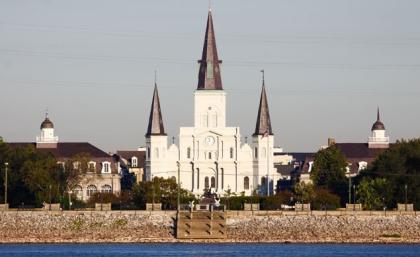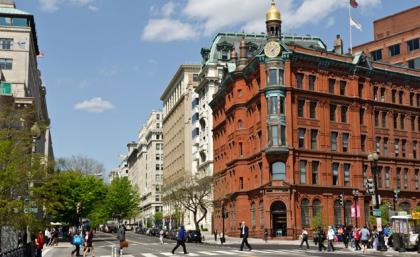10 places every American should see
What makes a place essentially American? Besides being within our borders, of course? When the Budget Travel editors set out to compile a list of can't-miss destinations in the United States, we knew there was no one answer.
MORE AT BUDGET TRAVEL
A place couldn't be just historic, or only very beautiful, or merely iconic. But in the best cases, it might be all three. For days (and weeks), ideas were floated, debates were had, some favorites were voted down and others prevailed. The list we arrived at is no American-history textbook quiz—although historic sites are there, along with a sampling of cultural, nostalgic, and guilty-pleasure spots that, we think, evoke the kaleidoscopic American experience.
So why not map out a detour to one of these spots the next time you hit the road? Who knows—you might never think of this country in quite the same way again.
Yellowstone National Park, Wyo.

Wide-open space is a unique inheritance for every American, and Yellowstone is the most dramatic example of what "wide-open space" really means. In 1872, two-million-acre Yellowstone debuted as America's first national park, and visitors began flocking to soak in its hot springs, see elk and bison roam its grasslands, gawk at its geyser known as Old Faithful, and hear gray wolves sound chill-inducing howls at dawn. Amazingly, visitors can get the same thrills today for nearly no cost. For the fullest experience, stay the night. The lack of light pollution in northwest Wyoming's Big Sky country reveals an astonishing canopy of stars that is virtually unchanged from the time of native tribes, fur trappers, and pioneer explorers.

French Quarter, New Orleans, La.
No other American neighborhood provides as much eye candy as the cobblestone streets of New Orleans' French Quarter—known as "the Quarters" to locals—and we're not referring to the annual Mardi Gras parades, with their thousands of taffeta-draped harlequins strutting to funk, R&B, and Dixie. No, it's the architecture that's intriguing.
Stroll this district, which is bounded by the Mississippi River, Rampart Street and Canal and Esplanade, and you'll glimpse nightclubs lit up in neon, French colonial townhouses draped in ivy, Creole cottages built on stilts, and antebellum mansions whose balconies are laced with intricate ironwork.
Highway 1, California

Considering that the United States has more miles of paved roads (over 2.5 million) than any other country on earth, is it any wonder that road trips are practically a rite of passage here? One of the most meditative—and celebrated—drives you can take in the States is the 135-mile stretch of California's Pacific Highway 1 between San Luis Obispo and Monterey. Expect view after astonishing view of land meeting sea, as the road snakes and swerves high above the Pacific, past bright-green grasslands and redwood-forested canyons.

Times Square, New York City
Sure, the crowds can be pushy, but Times Square—the stretch of Broadway between Manhattan's 42nd and 47th streets—delivers the most intense straight-up celebration of round-the-clock visual stimulation in the free world. Three-hundred sixty-five days a year, it's all lights, cameras, and action. And in summer, when the city sets out a slew of lawn chairs in its pedestrian-only core, you can take a seat and gaze southward, imagining the scene every New Year's Eve when a million revelers watch the ball drop—an all-American tradition for 105 years.
Grand Canyon, Ariz.

Many American landmarks inspire people to think big, but none can match the leviathan scale of the Grand Canyon. As with anything worthwhile, a mind-melting view of the fire-hued, half-mile-long rock faces at the Grand Canyon must be earned. Take a half-day or overnight mule trip, which involves a guided ride along the canyon rim and down to the Colorado River.
Your souvenir—aside from a newfound appreciation for more comfortable forms of transportation—will be the vivid sense of timelessness that you can only get from observing a geological wonder more than a million years in the making.

Taos Pueblo, N.M.
At the northern edge of the artist colony of Taos and a couple hours' drive north of Santa Fe, Taos Pueblo is a set of adobe dwellings, ranging from two to five stories tall, whose walls gleam in the sun of the high desert. Some of the 2,000 Tiwa-speaking people who live on an adjacent reservation continue to use this six-century-old settlement for ceremonial rites, such as for the Deer and Matachines Dances, which are usually performed to the sound of heavy drum beats. The Taos Pueblo contains the largest collection of multi-story pueblo dwellings in the country—well worth its UNESCO World Heritage status—and provides an uncommon insight into the culture of the first Americans.
South Beach, Miami, Fla.

Even in typically overstated Miami terms, no place in the country captures Latin-tropical chic like South Beach, with its 23 pastel-hued blocks of hotels, shops, restaurants, and cocktail bars south of Dade Boulevard. Glamorously restored art deco and art moderne hotels dominate Ocean Drive and Collins Avenue, which run parallel to the Atlantic. Check out the high-rise Raleigh, with its curvaceous swimming pool; the Delano, a glossy white Philippe Starck confection; and the Mondrian, with its super-sized chess pieces standing guard near an ebony staircase. Given an average year-round temperature of 75 degrees, SoBe always draws a pretty crowd for people-watching along its ocean promenade.

Gettysburg National Military Park, Gettysburg, Pa.
Compelling battlefield tours are difficult to pull off, as there's often little to see. But Gettysburg, the most visited of Civil War battlefields, manages the trick. At the four-year-old, $135 million visitor's center, a 20-minute film narrated by Morgan Freeman explains how the three-day fight unfolded, while an 1884 Cyclorama depicts an infantry assault in a 359-foot-long-by-27-foot-high wraparound oil painting. Once you're oriented, drive the park's paved roads (a rented audio guide enhances the experience).
The landscape you'll see is close to what the blue and grey saw, as the park service is slowly restoring tracts of land and forest to how they would have looked during the battle. Be sure to stop at Little Round Top, where 1,600 soldiers died in just a few hours of fierce fighting—a small portion of the overall grim death toll.
Pearl Harbor, O'ahu, Hawaii

This year marks the 50th anniversary of the USS Arizona Memorial, which honors the men who died on the famous battleship sunk in 1941's Pearl Harbor air raid. A scale model of the ship inside the monument's museum gives a sense of what it must have been like to be on the vessel while it was under attack, and public tours include a 22-minute movie presentation, followed by a visit to the Memorial itself. Nearby, a nonprofit group maintains the Battleship Missouri Memorial, which was the site of the formal Japanese surrender, while a preserved World War II submarine can be explored at the adjacent USS Bowfin Submarine Museum and Park, run by another independent group.
National Mall, Washington, D.C.

There's no place in America where you get more historical bang for your buck than the National Mall—fitting, since two of its most famous memorials (to Lincoln and Jefferson) are stamped on our smallest coinage. This less-than-two-mile stretch of our capital city packs in those memorials, plus the Washington Monument, the Vietnam Veterans Memorial, and the new Martin Luther King Jr. Memorial, among others, and it's lined with Smithsonian Institution museums—none of which cost a dime to enter.
See more places every American should visit.

